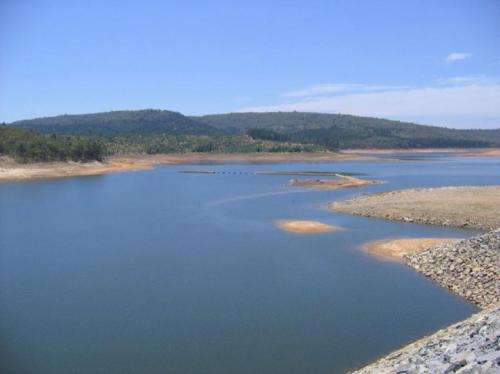Care needs to be taken not to harm river catchments. Credit: Bram Souffrou/Wikimedia Commons, CC BY-SA
Should we pick and choose our climate strategies based on how water-wise they are?
As our new research published in Climatic Change shows, some activities aimed at tackling greenhouse emissions can also consume large amounts of water. In a water-poor country like Australia, this can make a real difference in the relative economic attractiveness of these strategies.
In particular, wide-scale planting of trees to store carbon can be very water-intensive, and we should therefore consider carefully where we do it.
However, there is good news too. Reducing our electricity demand through energy efficiency and shifting to renewable sources can not only reduce our carbon footprint, but also our water footprint too. Burning coal for electricity consumes water, so if we can reduce this demand and shift to more sustainable technology, more water may become available for the environment and other uses.
The water costs of carbon farming
Planting trees is a major plank of Australia's climate policy, to be delivered by programs such as the Green Army and the 20 Million Trees initiative.
Although 20 million trees sounds like a lot, at 1000 trees per hectare it only adds up to about 20,000 hectares. But elsewhere there are millions of hectares that could potentially be planted by the carbon forestry industry.
The Carbon Farming Initiative, which allows land owners to earn credit for storing carbon in trees and soils, recognises the water impact of forests as a potential issue, and has regulations in place to manage it. These include a list of eligible planting zones, and limits to tree planting in areas that receive enough rainfall to generate water runoff (at least 600 mm a year), which is aimed at stopping trees from sucking up water from river catchments.
But there are several loopholes in the regulations, and the National Water Commission, which reviews the planting zones each year, will be abolished in December.
Another way to manage the impact of trees on water is to issue licences for commercial forestry, as is happening in South Australia. While this policy has its opponents, it makes sense that water use is accounted for and that users pay for the water they consume.
Trees can provide many other benefits, such as creating animal habitat, slowing erosion, reducing salinity, and moderating flooding. We shouldn't avoid planting trees as a climate strategy, but it needs to be carefully planned on a region-by-region basis across Australia.
What can we do to lessen the impact?
Apart from carefully planning where trees are planted, there are some technology choices that can reduce the water footprint of clean energy.
Thermal power stations use water to generate steam and to cool the heat generated in electricity production. On average, Australian coal-fired power plants consume about 1.5 million litres of water for each gigawatt hour of electricity production. The five power stations in Victoria's Latrobe valley use more than 100 gigalitres of water each year - around 300 million litres every day. The potential adoption of solar thermal or geothermal energy in drier areas of the continent could also lead to excessive water demands.
There are several other options for cooling thermal power plan. "Dry-cooling" obviously uses far less water, and has already been used at a few power stations, such as Kogan Creek in Queensland. But as it relies on heat exchange with the atmosphere, such power plants operate less efficiently in hotter weather.
A solar thermal power plant nearing completion in Nevada incorporates a hybrid cooling system that uses much less water than conventional systems. This means that water can be used for cooling when air temperatures are too high for dry-cooling alone.
Solar photovoltaic and wind generators use very little water directly, although they need to be linked to other energy stores and generators to smooth out their power supply. Existing pumped storage hydropower stations in eastern Australia, currently used to back up coal-fired generators, could be used for this purpose.
An issue for arid places everywhere
Clearly water conservation is an issue in Australia, which is largely an arid country. Even in Australia's temperate zones, most water is already allocated to other uses. Currently, California is in drought and facing reductions in hydro generation and forced to look for alternative sources of water to cool power plants.
Switching to new energy sources and implementing other mitigation strategies will change the places where water consumption occurs in Australia. In the future, water consumption is likely to drop in coal-dominated places like the Latrobe and Hunter valleys, while increasing in places where efforts are made to store carbon in the landscape, and potentially where new renewable power stations are being built.
The issue of water shortage is not going away – in fact, it will become more important as more areas of the world experience increasing drought as a result of climate change. Tackling greenhouse emissions is a priority, but it needs to be done in a way that minimises the impacts on water.
Journal information: Climatic Change
Source: The Conversation
This story is published courtesy of The Conversation (under Creative Commons-Attribution/No derivatives).
![]()






















